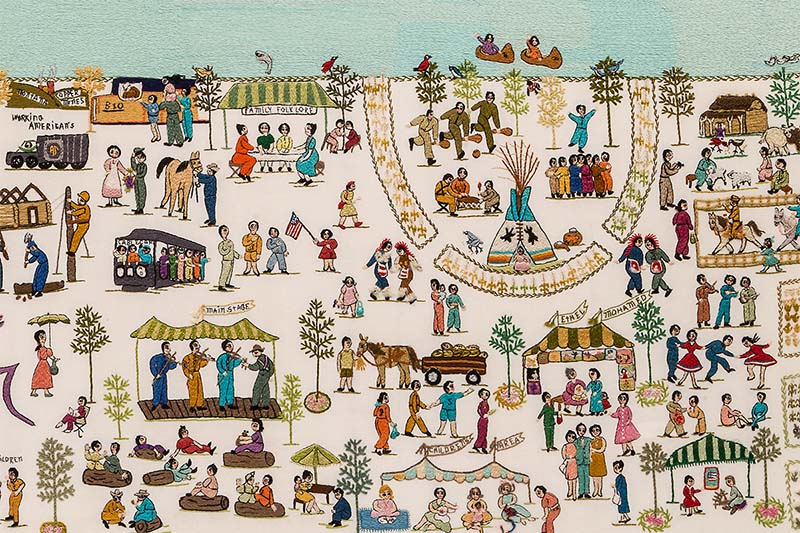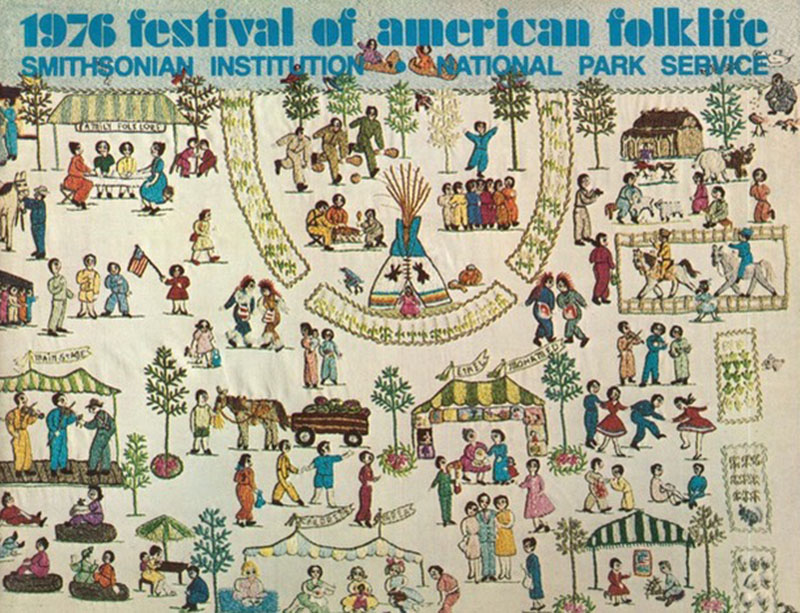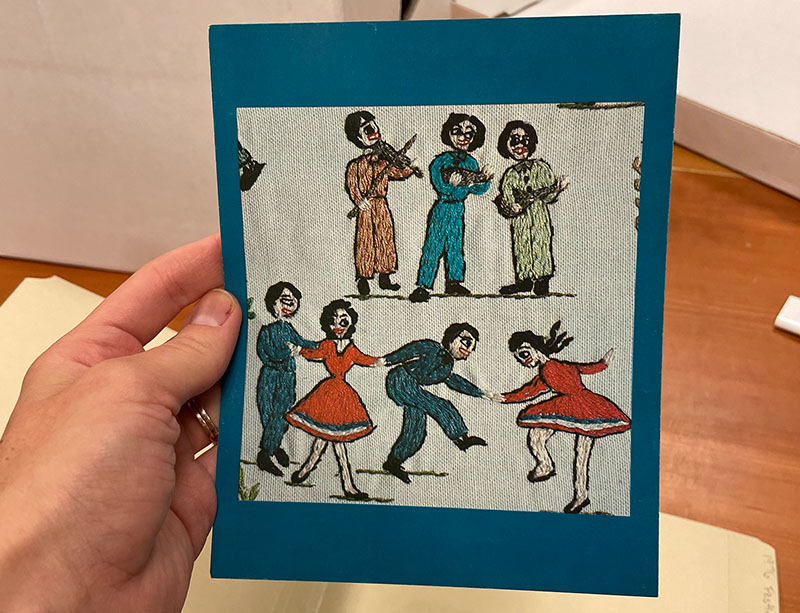What Do Embroideries and Festivals Tell Us About Shaping the Nation?
by Rachel Winter
This past fall, I was the first external researcher welcomed into the archives at the Smithsonian Center for Folklife and Cultural Heritage (CFCH) since the pandemic. My week-long visit, supported by a Decorative Arts Research Grant, gave me access to the object at the center of my research for the last three years: an untitled work by Mississippi embroiderer Ethel Wright Mohamed commissioned for the 1976 Smithsonian Festival of American Folklife (figures 1 and 2).
Figure 1. The author in front of an untitled embroidery by Ethel Wright Mohamed commissioned for the 1976 Festival of American Folklife, made c. 1975-6. Material Culture Collection, Smithsonian Center for Folklife and Cultural Heritage, MCC 211. Photo by the author.
I went to the CFCH to see Mohamed’s work in person, and to explore archival material related to the 1973-6 iterations of the Smithsonian Festival of American Folklife (renamed the Smithsonian Folklife Festival in 1998). Mohamed’s embroidery has received little scholarly attention, and the Center for Folklife and Cultural Heritage Papers are rarely cited in the extant literature. During this four-year period, the festival created a new section called “Old Ways in the New World” that featured populations who immigrated to the United States and the traditions they carried with them in order to highlight the diversity of the nation leading up to and during its bicentennial. The goal was to produce a more unified nation, or perhaps a new multiculturalism, through the festival’s educational opportunities. I wanted to understand the frameworks that informed “Old Ways in the New World” and how they intersect with craft and decorative arts.
My research into the Festival of American Folklife is one aspect of my dissertation, which posits that festivals in the 1970s generated important public interest in the Arab world at a moment of increased immigration and that this interest facilitated a later focus on contemporary art from the Middle East, specifically by American and British art museums.
After reading the archives and its omissions, I took away two key findings that will help me think through the role objects played in educating people at festivals, and what kind of knowledge festivals generated about the Arab world and its diasporas. First, the presence of people and traditions from places like Egypt, Lebanon, Tunisia, Israel, and Pakistan at the Festival of American Folklife was achieved through governmental negotiations. This observation is important because it suggests that representations were shaped by individuals from both foreign and domestic governments at an event paradoxically designed to invert the power structures of museums by allowing people to present their own traditions. Participants still shared their cultural practices through live workshops and performances, but what was selected for the festival was greatly mediated.
Secondly, participating people and traditions were chosen based on the idea of a “cultural cognate.” This term, which appears frequently throughout the festival’s archival material, refers to the ways that traditions or practices, such as craft or cuisine, had to have direct equivalents in the US and abroad in order to be present at the festival. Shared traditions and practices, such as dabke dancing by Lebanese and Lebanese-American presenters, were identified through domestic and international fieldwork by scholars considered experts in their fields.
But what do these points have to do with craft and the decorative arts? The material that is absent from the archive answers this question and speaks to the necessity of broad research practices and multiple approaches to answering research inquiries. The archive reveals the way people admired Mohamed’s creativity, shows her invitation to make the work, and conveys a warm reception to her monumental embroidery when revealed in 1976. But Mohamed’s embroidery was similarly shaped by processes of negotiation and mediation, a narrative not detailed in the archive. Mohamed’s embroideries were often a means for her to document her memories in the absence of photographs. For her 1976 festival embroidery, she began with her jovial memories of community, gathering, and learning after participating in the 1974 festival as a representative of the state of Mississippi. This participatory, collaborative spirit was transformed into a creative foretelling of the 1976 festival. Festival organizers guided Mohamed on how to outline an artwork with a layout, sections, and key names that matched the content and presentation of the upcoming festival in 1976. What might look like a memory of the festival was actually a carefully planned vision that conveyed what the festival would be, and the types of experiences they hoped audiences would have as they learned about different cultures, traditions, and practices.
In this light, Mohamed’s embroidery, and other related works of visual and material culture, became conduits for projecting ideas of the nation shaped by governmental negotiations and cultural cognates. Mohamed carefully identified each section of the festival in her work to show the diversity of participants, and she made sure each festival attendee and presenter was given individual attributes. When brought together at the festival, these differences were celebrated and posited as integral to forming a united nation, or a new multiculturalism on the occasion of the bicentennial. Mohamed shows this ideal in the form of people gathering, dancing gleefully, conversing, eating, and watching performances. Although her work was on display at the festival, portions were also reproduced on the cover of the program (figure 3) and on postcards (figure 4) to disseminate this sense of joy as people came together in celebration. Festival organizers hoped people would move into the future with a similar spirit.
Figure 3. Program Cover for the 1976 Smithsonian Festival of American Folklife Featuring embroidery by Ethel Wright Mohamed, 1976. Courtesy of the Ralph Rinzler Folklife Archives and Collections, Center for Folklife and Cultural Heritage, Smithsonian Institution.
In this way, craft and festivals were employed as equalizers, but both are mediated processes of representation, something we learn about in more detail by spending time with objects and in archives. Festivals are considered useful venues of presentation for their potential to upset the power hierarchies of museums where curators have the privilege of sharing stories through the presentation of objects. Instead, festival presenters were given the agency to share their own traditions and cultural practices. When these moments of exchange are presented through craft, such as in Mohamed’s embroidery, there is an opportunity to draw attention to this inverted power structure and contemplate what might emerge from a new way of sharing and learning. Yet behind each moment of representation is a force, sometimes unseen or obfuscated, shaping the way knowledge is encountered. Perhaps we cannot always see this power in the moment, but, in hindsight, we can better understand our present and future in which educational events and visual culture remain key conduits for fostering unity in fractured societies and nations.
Before I ventured on this trip, I spent a great deal of time thinking about Mohamed’s work, speaking to Mohamed’s family, and conducting supplementary research at her home in Mississippi. I had a sense of how I thought this work functioned, but my understanding of it changed dramatically as I read in the archives about how the festival itself took shape, and slowly began to comprehend the ways these different histories and narratives overlap. I am grateful for the support of the Decorative Arts Trust that allowed me to undertake a much closer investigation of Mohamed’s embroidery and the Smithsonian Festival of American Folklife, and I look forward to developing and sharing my research about the role of visual culture and festivals in reshaping museum collections in the coming years.
Rachel Winter is a PhD Candidate in History of Art and Architecture at the University of California, Santa Barbara. She is also the Assistant Curator at the Eli and Edythe Broad Art Museum at Michigan State University.
About The Decorative Arts Trust Bulletin
Formerly known as the "blog,” the Bulletin features new research and scholarship, travelogues, book reviews, and museum and gallery exhibitions. The Bulletin complements The Magazine of the Decorative Arts Trust, our biannual members publication.
Click Images to Enlarge
Did you know that clicking on the images in Bulletin posts will allow you to get a closer look? Simply click on an image, and a larger version will open in a pop-up window.











